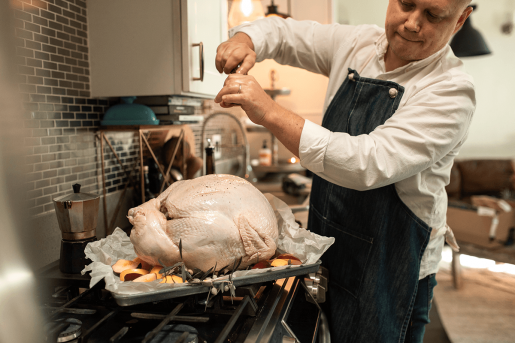Gobble up your Thanksgiving turkey with these healthy cooking tips
Turkey takes center stage at the Thanksgiving table, and there are a number of ways to prepare it. A Baylor College of Medicine registered dietitian explains the various methods of turkey preparation while providing tips to make your meal healthy and flavorful.
 Roasted
Roasted
Roasting a turkey uses minimal fat and doing so at a moderate temperature preserves the essential nutrients of the turkey. You should achieve an oven temperature of about 325 degrees Fahrenheit to ensure the turkey is cooked well. The internal temperature should reach 165 degrees Fahrenheit at the thickest part of the thigh and breast for safe consumption.
“To verify the temperature, use a meat thermometer,” said Dr. Luis Rustveld, registered dietitian and assistant professor of family and community medicine at Baylor.
Grilled
Grilling turkey is another low-fat cooking method, as it allows some of the excess fat drippings to fall off the turkey, reducing its fat content. The internal temperature should reach 165 degrees Fahrenheit. If you marinate the turkey, use a low-sugar, low-sodium marinade.
“Be mindful of using high-sodium and high-sugar marinades, as they make the dish less healthy,” Rustveld said.
Fried
When deep frying a turkey, you introduce a lot of oil in the preparation, so make sure to use oils with a high smoke point, such as peanut oil, canola oil or grapeseed oil. These oils are less likely to release harmful compounds if you overcook your meat. While you can use olive oil for roasting, avoid it when grilling or deep frying a turkey.
The turkey must be dry and thawed completely before inserting it in the oil to avoid splatter and potential fires. When deep-frying turkey, maintain the oil temperature at around 350-375 degrees Fahrenheit. The turkey should reach an internal temperature of 165 degrees Fahrenheit in the thickest part of the thigh and breast for safety.
Rustveld suggests air frying your turkey as a healthier alternative to deep frying. It takes less time at 400 degrees, and the end product contains less fat since you do not need to add oil.
“Deep frying is not as healthy as air frying, roasting or grilling,” he said.
Stuffing and flavor
Roasted or grilled turkey can be stuffed, but Rustveld recommends serving stuffing as a side dish if you deep fry your turkey. Deep frying makes it difficult for the stuffing to reach a safe internal temperature.
To create a healthy stuffing, use whole grains like brown rice or quinoa and chop up celery, carrots, mushrooms or other vegetables of your choice. Add herbs and spices instead of increasing the salt content.
Prepare your own healthier gravy by using drippings from the turkey and mixing them with a low-sodium broth. Some recipes call for cornstarch to thicken gravy, but Rustveld recommends using potatoes to thicken the gravy. You can also add spices for more flavor.
Keep your turkey moist by using a salt rub (without using too much salt) that includes spices. The salt will help draw out moisture, but it will also be reabsorbed, making the turkey juicy and flavorful. Injecting spices and herbs into the turkey with some butter or oil will also retain its moisture and enhance flavor, but it’s important not to overdo it as excessive injection can lead to greasy or overly fatty results.
“You can make a turkey that is healthy during preparation, but if you pour ingredients that are high in fat and salt over healthy food, then you’re undoing all the goodness of the product,” Rustveld said. “Go for more flavor rather than increasing the salt content.”
By Homa Warren



